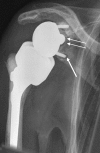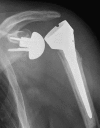Reverse total shoulder arthroplasty-from the most to the least common complication
- PMID: 20865260
- PMCID: PMC2989053
- DOI: 10.1007/s00264-010-1125-2
Reverse total shoulder arthroplasty-from the most to the least common complication
Erratum in
- Int Orthop. 2011 Mar;35(3):455
Abstract
Reverse total shoulder arthroplasty (RTSA) has been reported to be associated with a complication rate that is four times that of conventional total shoulder arthroplasty. It is the purpose of this article to identify and understand the most common and most serious complications of RTSA and to review current methods of prevention and treatment. The current literature was reviewed to identify type and prevalence of reported complications and to identify risk factors, preventive measures as well as technical details for management strategies for complications of RTSA. The variable accuracy of reporting and the heterogeneity of methodology in the literature limited our study, however, a definitive ranking of most to least common complication emerged. The currently identified most common complication is scapular notching. The clinically most relevant complications are infection, instability and acromial fractures. Haematoma formation used to be very frequent but can be controlled, glenoid component loosening, however, is rare when compared with conventional total shoulder replacement. In conclusion, RTSA is associated with a high rate of complications. Their incidence and the results of their treatment are inconsistently reported. To document and then prevent complications, a standardised monitoring tool including clear definitions and assessment instructions appears necessary.
Figures





References
-
- Molé D, Favard L. Excentered scapulohumeral osteoarthritis. Rev Chir Orthop Reparatrice Appar Mot. 2007;93(6 Suppl):37–94. - PubMed
-
- Boulahia A, Edwards TB, Walch G, Baratta RV. Early results of a reverse design prosthesis in the treatment of arthritis of the shoulder in elderly patients with a large rotator cuff tear. Orthopedics. 2002;25(2):129–133. - PubMed
Publication types
MeSH terms
LinkOut - more resources
Full Text Sources
Medical

